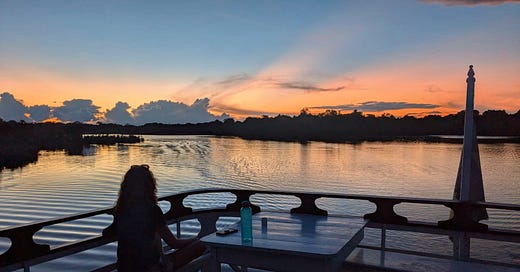Two hunters, two Brits and two vegetarian Hindus go camping
.Curry and grubs for dinner in the Amazon
This time a couple of weeks ago my Brazilian buffet habit took a backseat while I chomped down on live grubs in the Amazon. Specifically, the larvae of a coconut borer beetle (locally, “bicho-de-coco”) which had been freshly picked out of a coconut shell and handed to me by our rainforest guide, Elso.
There was never really much consultation with Elso, we tended to just do as he said or gestured because he commanded that kind of presence, and because we were relying on him to keep us alive. Deeply knowledgeable, quietly authoritative; we were all a tiny bit in love with Elso and just the right amount of scared of him, too.
There was also a certain level of honour in being selected to be the one to do the horrible thing – could it be that he thinks me the bravest gringo of them all?? – I wouldn’t let him down. “It tastes like coconut,” he told me. And yeah, I guess it did – once I’d managed to chew through the tough, wriggling skin and the poor thing’s juices finally burst out.
That’s the unexpected thing about eating a grub – you can’t just nibble off the end of its tail because there’s no purchase. It’s a bit like grabbing a half-deflated balloon with one hand and trying to burst it: you can’t, because the air, or in this case the liquid, simply slides out of your grip. No choice but to pop the whole thing in my mouth and “really chomp it”, Elso advised. So I did. And then I spat its remains out onto the forest floor at the feet of the two cowering Hindu vegetarians there with us. “Yep, tastes like coconut,” I confirmed. “Sorry, I probably could have just eaten a coconut…”
We were about three days into our five-day tour, somewhere south of Manaus on the Paraná do Mamori river, and by this point I’d already held a live caiman and a dead tarantula, so eating a semi-cognizant bug seemed like a natural next step in my journey towards becoming fully subservient to Elso. Over the coming days I would also agree to sleep in a hammock in the rainforest barely a metre away from a tarantula’s nest, and voluntarily put my hand in an ant’s nest under the promise that they would provide a natural mosquito repellent (I think it worked?). My takeaway from all of this is that yes, I’m obviously very brave, but I’m a terrible vegetarian.
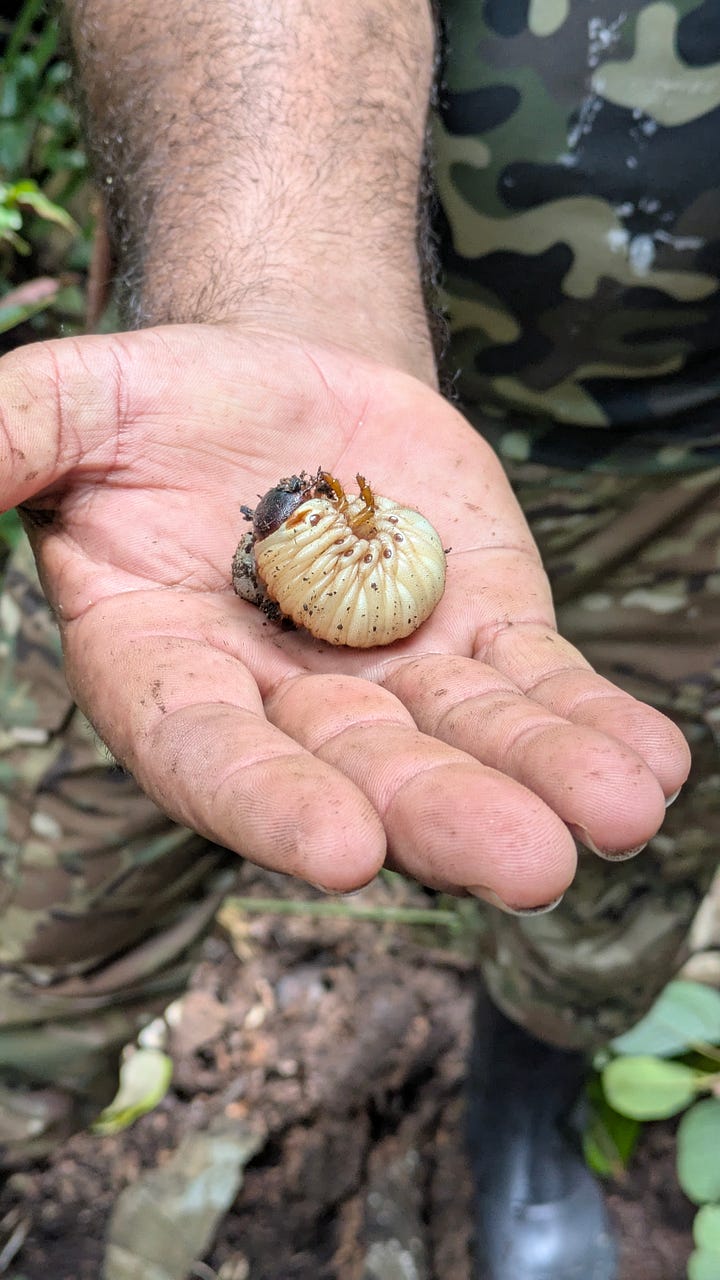

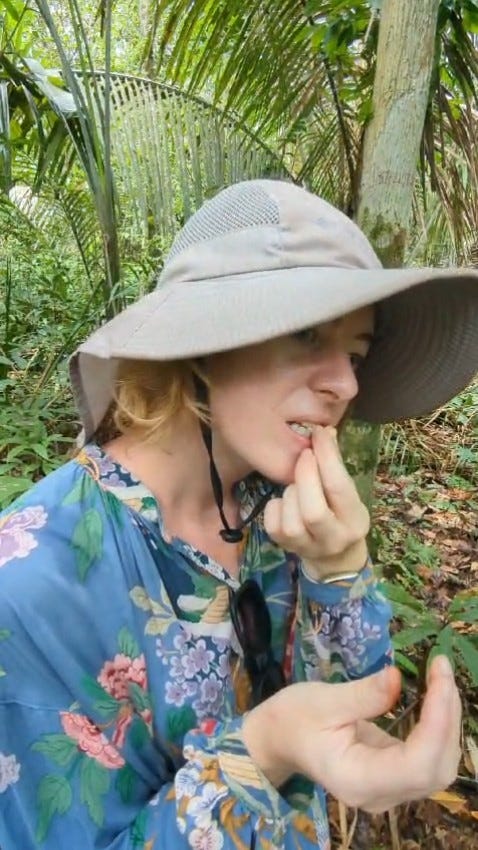
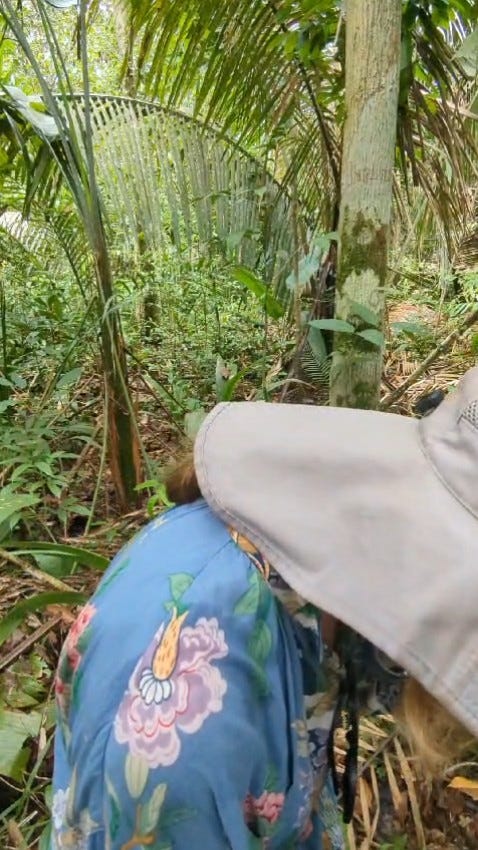
After kicking off 2025 with a couple more glorious weeks by the beach, it was time for Dave and I to dust off the wide-brim hiking hats for another trip to the Amazon. Goodness knows I’ve given enough paragraphs of this newsletter over to evangelising the buses and condemning the taking of unnecessary flights, but I quickly made my peace with flying once I realised the distance from Rio to Manaus, our jumping off point for the Amazon, is further than that of London to Istanbul. It would take a hell of a long bus to get up there, and (to my devastation) our time on this trip is not infinite.
Some dogged Skyscanner research revealed to us that the cost of flying to Manaus direct from Rio was almost twice that of flying from the neighbouring city of Belo Horizonte, via São Paulo to the south. Could we fly directly from São Paulo, cut out the middleman? Apparently not – it would cost almost three times as much without the connecting flight. Absolute madness. So for the sake of saving literally hundreds of pounds, we took a very pleasant daytime bus from Rio to Belo Horizonte and camped out there for a night, which was no hardship.
Manaus has long been a pinpoint on my mental map of our journey around the continent. The city has a bit of a rough reputation – unfairly so, in my view. Sort of by chance, I had started reading Ann Patchett’s State of Wonder in the days leading up to our visit, which was lucky because it reminded me to get some malaria meds, but it also gave me a negative picture of Manaus. I imagined crowds of people and tourism touts hassling us – but in reality there was none of that.
The city itself has a pretty centre – lots of lovely bars dotted around the main square outside the iconic opera house – which is unlike any other opera house you’ll ever see. It wasn’t particularly busy, people were very friendly and we didn’t see a single person harassing tourists for tours.
Manaus is a major transport hub and its port connects trade between the Amazon and the rest of the country. Like any port town, you probably wouldn’t want to hang out around the docks late at night, but it’s hardly the threatening place some reports would have you believe. My sense is that, as is often the case with such things, crime exists in Manaus but it’s mostly smuggling and gang related, and not anything that your regular, sensible tourist would come into contact with. We walked around the city with no problems. Sure, there was a homeless guy with no pants on sleeping in the atrium of the Bradesco bank, but he stepped away very obligingly and gave us a wide berth while we used the cash point. What a charmer.
Of course none of this reasoning stopped my parents from sending me scaremongering articles about “deadly Manaus” accompanied by one word conclusions such as “concerning”. I get it, the stats can look worrying when they’re regurgitated mindlessly onto the page like that. But stories like this are just clickbait with headlines that often don’t match the content (trust me, I used to work for one of these websites). This one even claims the city has been “closed to visitors for eight years” which is just total nonsense.
Our first bite of the Amazon was in Iquitos, Peru, which I absolutely loved – even more so for the adventure that was getting there. I felt nervous about how a Brazilian rainforest excursion could compare… and so we decided to do things a little differently this time by staying on a houseboat. Fancy.
We went with Elso’s company, Amazon Green Tours, because he had excellent reviews, though admittedly our decision was swayed when we saw that one of the other companies we were considering had recently been accused of filming female guests in the shower (always check the Google reviews!) The boat was beautiful and we dithered over whether to splash the cash, but it was so worth it. As our host and captain, Elso was hands down the best tour guide we’ve encountered during our 15-plus months of travelling – and how cool to wake up each morning floating on the river, watching dolphins jumping in and out of the water all around us.
Joining us for the week were Pritam – a 40-something Indian entrepreneur – and his very young, very beautiful wife, Prisha. They arrived late to meet us at the dock, a flurry of activity in expensive-looking jeans and sweaters despite the 36 degree heat and 90 per cent humidity. Dave and I sat sweating on a kerb, hiding from the sun while Pritam and Prisha sought out rain-jackets, rubber boots, vegetables… it emerged that they’d arrived in Brazil the previous week without any kind of sunscreen, mosquito repellent or even a single hat between them, despite coming armed with multiple large suitcases. All this ahead of a three-month tour of South America, culminating in Antarctica (“Will it be cold,” Pritam asked us? “Can we buy gloves in Buenos Aires?”)
They were chaotic, slightly rude, but warm and hilarious, uncontrollably excited for the week ahead. We got to know Pritam during the half-hour boat ride we shared across the river and two-hour drive away from Manaus that took us deeper into the jungle. “I have seen 75 per cent of the world,” he told us by way of introduction, meaning Spain, Cape Town, and New Zealand. “Starting next year I will have 12 children, it is my gift to the world,” he told us about three minutes into the journey, pointing at his wife: “She only wants one, haha!” Sweet, silent Prisha raised one finger to confirm this before they both fell about laughing and punching each other quite aggressively in the sides, which we soon learned was their love language. I don’t think either of them had a clue what they were in for over the coming days.
For two nights and three days, the four of us slept in our very comfortable respective cabins on the boat and we were well looked after by Elso, his powerhouse wife, Paula, and various members of their family. We rose at 5.30 to watch the sunrise and take early boat rides to see the monkeys waking up and the sloths settling down to sleep. We ate huge and delicious spreads for breakfast, lunch and dinner on board, and, something I hadn’t anticipated when I pictured our jungle tour, enjoyed some authentic curries after Prisha gave the onboard cook a crash-course in Indian cuisine.
We took afternoon hikes through the forest followed by more evening boat rides to spot caiman, tree frogs, snakes, owls and agoutis. We learned about the health benefits of the surrounding trees and plants and how to use the forest for survival. And every day our little boat travelled further along the river to a new destination, taking us deeper and deeper into the wilderness and revealing the many different landscapes I didn’t know existed in the Amazon.
And then on the third night we camped. I’ll admit I was more than a little hesitant after our last experience of camping. In Peru, we spent a sleepless night lying on nothing but a sheet of tarpaulin on the ground, listening to the every cracking twig and splash on the riverbank, waiting to be eaten. Our guides and protectors, Juan-Carlos and Carlos senior, snored through the whole thing, but fortunately the only predators we fell victim to that night were the mosquitos. It wasn’t an experience I was rushing to repeat.
Under the guidance of Elso and his quiet but steely-eyed assistant, Luciano, our Brazilian camping setup was a much more comfortable affair, largely thanks to the addition of hammocks strung under huge palm leaf shelters the lads had put together. Using nothing but the palm fronds and other bits of wood around us, Elso and Luciano even made us a functioning table and whittled down individual wooden spoons to go with our individual palm-leaf plates (which all begs the question, what were JC and Carlos playing at back in Peru, eh?).
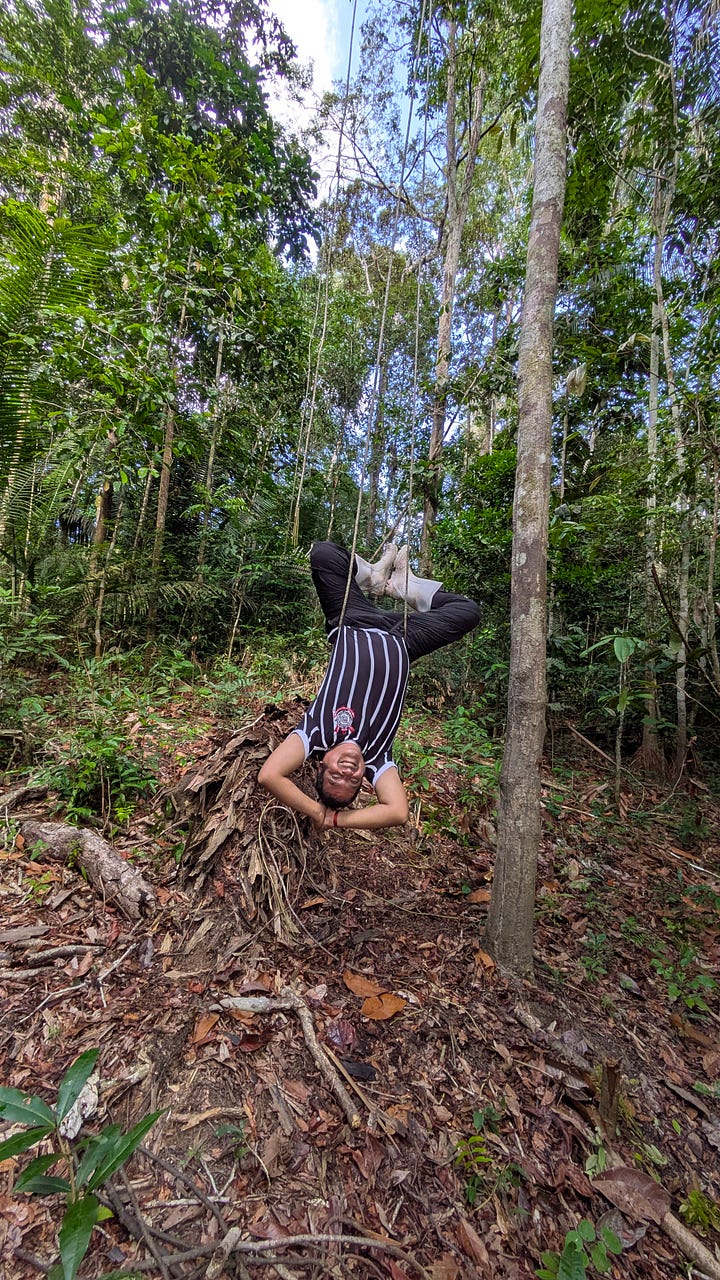
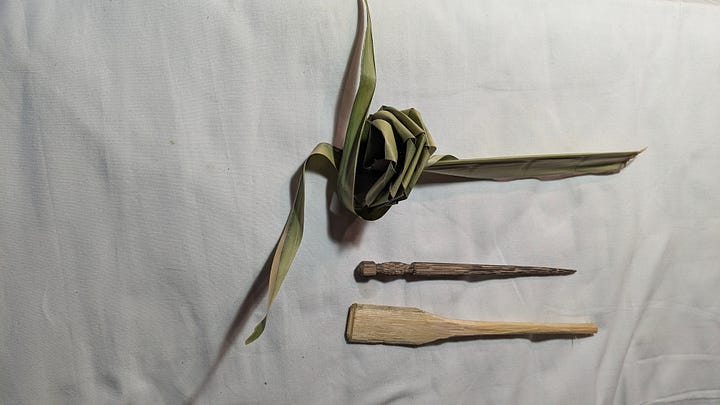
It was all excellent fun, and spirits in the camp were high as we sat down to eat the best fire-roasted chicken and freshly cut pineapple. Pritam and Prisha shared photos of their wedding with us, along with some of the vegan curry that the houseboat chef had provided them with for the trip (incredible scenes) and far too much information about their relationship (the phrase “she’s obsessed with me” has been circling around my head ever since). And yet even at this late stage I wasn’t convinced our friends had yet clicked onto the fact we were sleeping here.
I could see the moment of realisation hit as Elso tightened the strings to their hammocks. “But there is a back-up plan, surely? For if it starts to rain?” Pritam muttered to me conspiratorially. “If it rains, I get wet,” Elso shrugged, clearly enjoying himself.
“I am not sleeping here,” said Prisha. It was the clearest and most confident sentence anyone had heard her utter since the week had begun.
But do you know what? She slept there. In the same one-person hammock as Pritam, so goodness knows how. But the six of us passed the test and woke up the following morning feeling something almost towards rested. For two people who had arrived in the jungle wearing jeans – and who were clearly used to a very comfortable life back home – Pritam and Prisha had proven themselves to be great sports. And all this when, let’s be honest, the jungle lifestyle isn’t particularly geared towards veganism or indeed the Hindu respect for all animal life.
There were some unavoidable cultural clashes during our walks into the jungle. Elso and Luciano went to great lengths to show us how traditional local hunters like Elso’s father and grandfathers would set up very intricate traps made out of nearby branches for particular animals. Pritam would watch on, all the while offering polite greetings to the passing butterflies and joking that they might be his ancestors. This was a man who repeated “Blessings be upon you and may God grant me the ability to help all his creatures” every time someone sneezed. He and Prisha politely abstained from piranha fishing, understandably, and when I was the first to catch a big one, he was glad to take photos – but after a second or two would firmly start telling us put the fish back. If this trip through South America has taught me one thing, it's that piranha fishing is my unexpected innate talent, but I did feel guilty each time I caught one and sent it on its final journey down to Elso’s end of the boat.
Our unlikely group had some interesting conversations over the week, food and cultural differences being an obvious topic to return to. Since 1967, hunting and fishing have been illegal in the Amazon, the exception being if a family lives more than two weeks away from a shop by boat – hard to believe such a thing is still possible, but Elso assured us there still are hundreds of communities in Brazil who still live that remotely, and not just Indigenous tribes.
Of course the Amazon is enormous, and so plenty of illegal hunting, logging and mining still takes place. The problem, Elso said, was the lack of resources – countless governments and international organisations hand money to the government to protect the rainforest but the money rarely goes where it should. We saw one park ranger speed boat monitoring the river during our stay, but there aren't nearly enough eyes to watch for illegal activity taking place further in.
Elso is a fascinating character. He grew up in the region where we were staying, even taking us to see his old school one day. As one of 16 children, it sounds like his absence was barely noted when he took himself off to camp in the forest alone as a small child. In any case, he had his own boat and his own gun by age 12 (as did my dad, it should be noted, though there was arguably much less reason for that in Norfolk) and got into the “hunter mindset” as he called it.
Then when he was 13, Elso found some work at an eco lodge down the river. His perspective completely shifted, he told me – from seeing the forest as something to dominate and exploit to something that should be protected. He picked up other languages, including excellent English, just from meeting and talking to tourists, and has been working in ecotourism ever since.
I can see how a young person growing up in Amazonas could so easily fall into bad industries like hunting, wildlife trafficking or illegal logging. We met people there who had done it out of a sense of family pressure and because sadly it's often where the money is. Elso is living proof that responsible tourism can be a lifeline for communities like his. Thanks to his business, he was able to fund the construction of a fresh water pump to one of the local villages we visited – a project the government promised, and should have made happen, but never did. It was nice to feel like we were contributing towards something good.
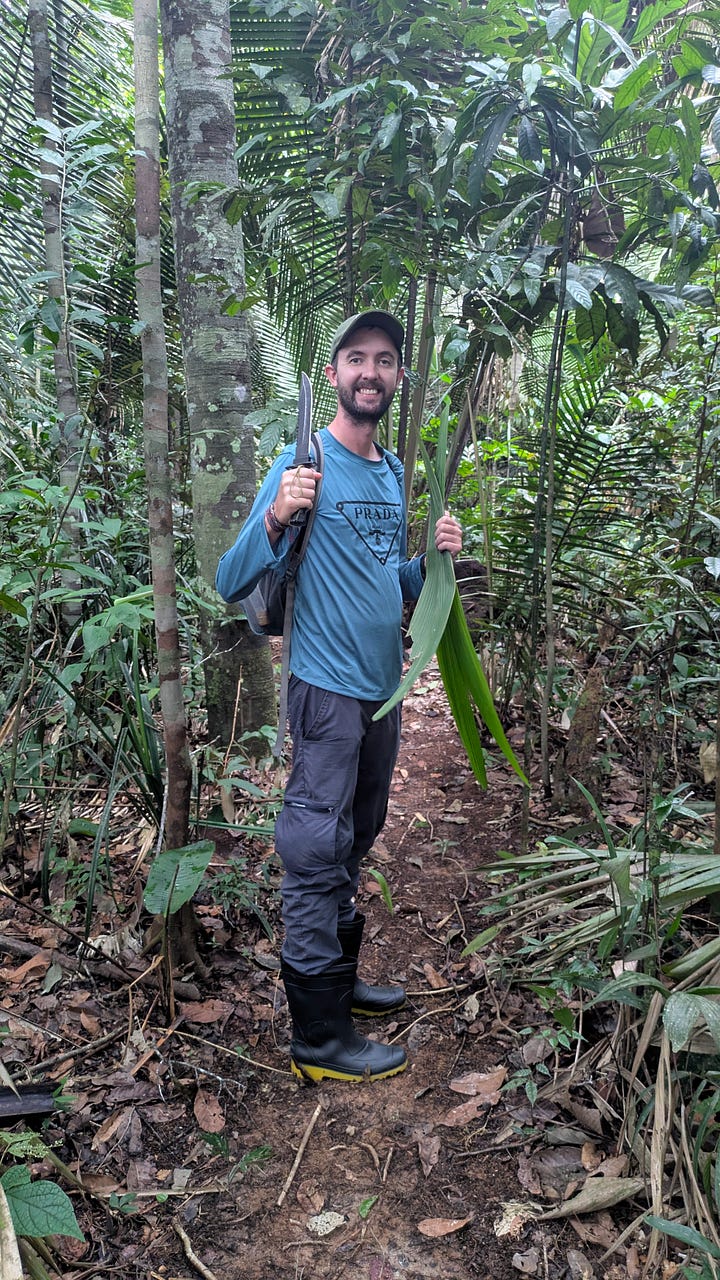
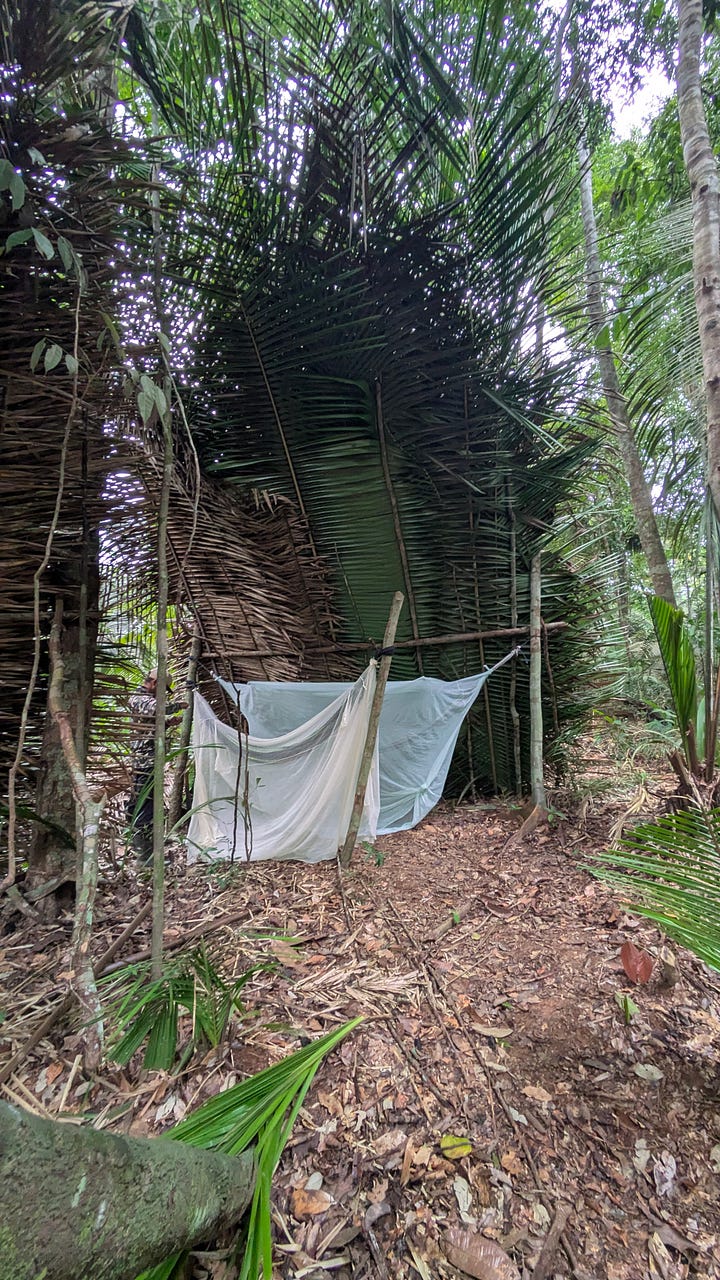
Safely back from camping, we were all looking forward to a shower and a final night spent comfortably on board the boat. Prisha certainly was. Pritam’s love affair with the rainforest appeared to have only deepened after his night spent in the wilderness, however. “I would love for there to be a heavy rainstorm so I can shower in nature,” he said. Noted.
As the four of us watched a spectacular sunset and the boat moved along the river once again, Pritam handed me his phone and instructed me to film him dancing. We’d already heard about how fans gather to watch Pritam singing karaoke from far and wide back in Maharashtra, and now we were privileged to experience his voice and his smooth moves first hand. He and Prisha ballroom danced across the deck for what felt like forever while I dutifully filmed. And then as if in some kind of fever dream I realised Dave had been summoned into the dancing sphere, his frozen grin adding a certain je ne sais quoi to their improvised three-person glide while the traditional Indian love ballad played again and again and again on loop.
A bemused member of the crew appeared behind me and was trying to sneak past but Pritam spotted him. “You will film us now!” he said to him, taking the phone off me and pulling me in to join the trance that I worried would only end with darkness or a man overboard. The knowledge that the video exists somewhere now, completely out of my reach, must be a feeling similar to when TV celebrities have committed a sex crime that they know will come back to haunt them when they least expect it.
Our final night on board was spent stargazing from the top deck of the boat while the crew prepared a churrasco for us all. Then, a final night safari on the boat and a few hours’ kip before another sunrise. Elso steered us back towards the “port” – really just a flatter section of riverbank where a dirt track would connect us to our onward travel back to Manaus – and finally the heavens opened to produce the dramatic rainforest storm that Pritam had so craved.
Dave was attempting to find Elso to pay him the cash we still owed when the storm hit, and as a result unintentionally bagged himself a front row seat in the cockpit along with Elso’s adopted son, Felipe while they waited for the worst of the rain to cease. Felipe started to crack up with laughter. It had been his idea to set up camera on the top deck of the boat to create a timelapse of the journey back along the river to port: something fun for the tour company’s social media pages. Now, he was watching the footage back and realised they couldn’t use it… in the middle of the recording, the scene had been interrupted by the appearance of an Indian man in his underwear, soaping himself down in triple time and raising his arms up to the sky in praise of nature’s shower.
Travel bits and tips from this week
In Manaus we stayed at the cheap and very jolly Farol da Barra Hotel before and after our jungle tour.
Said jungle tour was booked with Amazon Green Tours and I cannot recommend them highly enough. Certainly up there with the best things we’ve done on this trip, and in my life!
There’s a brilliant little juice bar called Skina Dos Sucos with a couple of branches around town in Manaus.
We enjoyed the lunch buffet at Largo Tacacaria e Restaurante* so much that we went back another night for dinner. [*Unfortunately when we returned to Manaus at a later date, this place had closed down!!]
Ditto for the happy hour at Tambaqui de Banda bar, right on the theatre square.
The most enormous portions of pasta were eaten at Casa do Pensador, a decent pizza was had at Pizzeria Splash, an indulgent coffee and chocolate cake at Valer Teatro (also a very plush bookshop with great toilets and aircon), and many beers at the more casual Bar Do Armando – all of which around the same square.

